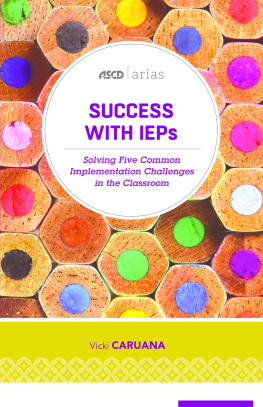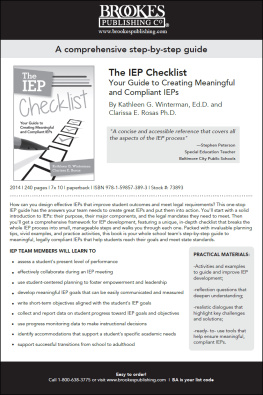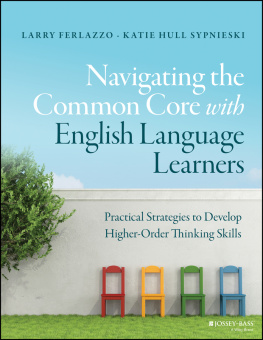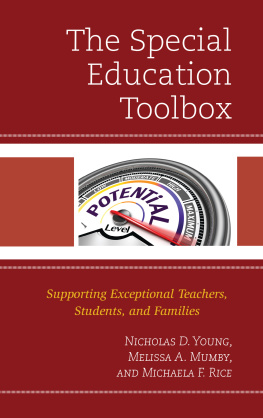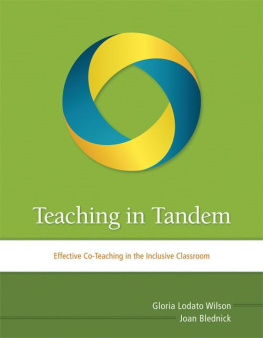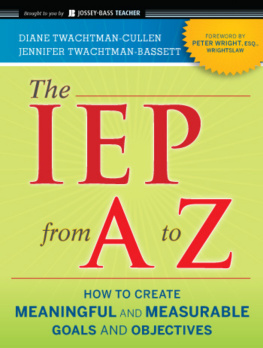


Introduction
You survey your class roster during preservice and notice symbols next to the names of particular children. Your class list looks like an indecipherable code waiting to be broken. Maybe you learned some code-breaking techniques during teacher preparation; maybe you have a natural affinity as a cipher; maybe you only learned enough to know there is meaning in the code but not the meaning itself. Either way, you are responsible for ensuring a meaningful education for all of the students in your charge, whether or not they have a symbol next to their name.
At the intersection of No Child Left Behind and Individuals with Disabilities Education Improvement Act (IDEIA 2004) lies the instructional responsibility of the general education teacher to provide meaningful access to the general curriculum for students with disabilities in their classrooms (McNulty & Gloeckler, 2011). For more than a decade, the implementation of higher state standards for both teacher preparation and curriculum for preK12 students has defined for us all the responsibility we hold for all children. Students with disabilities are expected to (1) be educated as much as possible alongside their peers without disabilities and (2) access the general education curriculum with appropriate supports (IDEIA, 2004). Because the most common placement for students with mild, high-incidence disabilities is the general education classroom, the teachers in this inclusive setting need to be prepared to be responsible for providing that access to the general curriculum.
During teacher preparation you may have taken an introduction to special education, inclusive education, or response to intervention (RtI) course that outlined the characteristics and needs of students with disabilities and ways in which you might differentiate your planning, instruction, and assessment for these students. You may have even been required to take and pass a certification exam in the area of special education in order to obtain a dual teaching license. You may have had neither of these experiences if you took an alternative route to teacher certification. Whatever preparation you have, you still may feel ill-equipped to ensure that you meet the needs of students with individualized education plan (IEPs) in your classroom (Samuels, 2013). This book outlines five things teachers who have success with IEPs do differently and practical insights, tips, and strategies for how you can achieve this same success with your IEPs.
Confidence is built on the foundation of competence. If you are uncertain of your ability to meet the needs of students on IEPs, this book is a great place to start. Once your competence increases, your confidence will increase. The principles and strategies in this book offer you a chance to fine-tune your practice as well as clarify some of the foggy ideas you may have about ensuring success for students with disabilities in your charge. Let's get started!

1. Realize the Full Scope of the Your Role in the IEP Process
As the teacher, you are in a unique position to make the IEP process a success, but you will need to get a sense of how wide-ranging your role could potentially be. Not only will you be leading implementation, you may also find yourself asked to complete a mountain of paperwork, observe one of your students for specific behaviors, or even come up with other ways you can be an active, and not a passive, member of the IEP team. Such a broad range of responsibilities means that you need to know how to reflect on and maximize your influence. This includes taking a hard look at your own beliefs and biases, knowing what to look for as you observe the children's learning, and remaining an active participant in their learning.
Look at Your Own Beliefs and Biases
We all have biases. These biases tend to color our attitudes toward any particular individual, group, or topic. If you feel any apprehension about working with a student on an IEP, it can be due to several causes. It may be that you believe you have a lack of experience to work with these particular students. It may be that you are skeptical about inclusion (Cassady, 2011). It may be that you struggle with the nature or types of specific disabilities. It may also depend on what level of support you have from administration and other teachers. Whether you hold a positive or negative attitude toward having students with a variety of disabilities in your classroom, it's important to conscious of the fact that your attitudes translate into actions. Your sense of efficacy (competence) grows out of your confidence as well as your genuine concern for each child.
Avramidis, Bayliss, and Burden (2000) reported that teachers who did not fully agree with inclusion were less likely to differentiate instruction according to students' needs and were less confident that they could implement the required accommodations and requirements of an IEP. Unfortunately, when teachers have negative attitudes toward including students with disabilities in their classrooms, they may not provide the needed supports for those students. Often teachers are more positive about including students whose characteristics or needs are not as likely to require extra instructional or management skills from the teacher (Avramidis et al., 2000). Where are you on the Attitudes Toward Inclusion Scale (Figure 1)?
Figure 1. Attitudes Toward Inclusion Scale

Although you may have an accepting or even celebrating attitude toward working with students who have an IEP, you may not feel prepared to do so successfully. Efficacy is a combination of confidence plus competence.
One new teacher I once worked with, Megan, was painfully aware of the weight of the responsibility she held for the four students in her 5th grade class who had IEPs. She viewed their unique needs as puzzles to solve, not obstacles to her dream of a problem-free classroom. Immediately Megan took time to meet with the case manager of each child and map out a plan to ensure that both she and her students were on top of their IEP goals. She had a lot to learn, but she hoped her willingness would outweigh her inexperience. Megan read through each IEP and wondered how she would manage so many individual goals. As the year progressed, Megan began to understand how to better address Justin's reading comprehension struggles, Sarah's difficulty with remembering math facts, Kyle's organizational challenges, and Jacqueline's expressive language frustrations. Was it possible to meet each of their IEP goals? Megan knew that something is always better than nothing, so her willingness to try made a huge difference in the support she gave these students as they pursued their individual goals. At the end of the year, after Megan had targeted instruction to improving Sarah's memory of her multiplication facts, Sarah improved her retention from 5 percent to 65 percent mastery. Although the criteria of 85 percent was not met, the amount of growth is considered a success.
Next page
